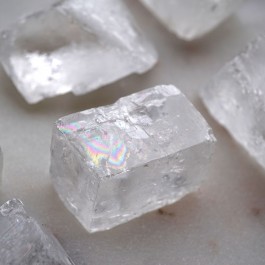CaCO3
At Mont Saint-Hilaire, one can find excellent crystals of calcite in several habits.
PHYSICAL CHARACTERISTICS:
Color ranges from colorless (very common) to beige, pale brown,
pale green and yellow (pale to lemon; the most common color).
Luster is vitreous.
Diaphaneity is transparent (on most), translucent and rarely opaque.
Crystal System is hexagonal; R3c.
Crystal Habits include tabular, prismatic, columnar, blocky or
platy to 10cm, large granular masses and small fine-grained
cleavable segregations and fillings.
Cleavage {1011} is perfect.
Fracture is uneven.
Hardness is 3
Specific Gravity is approximately 2.95 g/cm3.
Streak is white.
Associated Minerals include aegirine, albite, allanite, amphibole
group, analcime, ancylite, apophyllite series, catapleiite, chlorite
group, cordylite, elpidite, fluorapatite, fluorite, molybdenite, natrolite,
nepheline, pectolite, polylithionite, pyrite, pyrophanite, pyrrhotite,
quartz, rhodochrosite, rutile, siderite, synchysite and zircon.
Distinguishing Features: Crystal habits.
Origin: Named in 1845 after a Greek root meaning to reduce to
a powder by heat (also Latin calx, burnt lime).
CLASSIFICATION:
Dana System
# 14.1.1.1
Strunz Classification
# V/B.2-20
REFERENCES:
MinRec 21:301 (1990), Dana 8:428-434 (1997)
DISTRIBUTION AND RARITY AT MONT SAINT-HILAIRE:
MSH PE AP MX SS MC HF BR SX FR
¤¤¤ ¤¤ ¤¤ ¤¤ ¤¤ ¤¤ ¤¤ ¤¤ ¤¤ —

